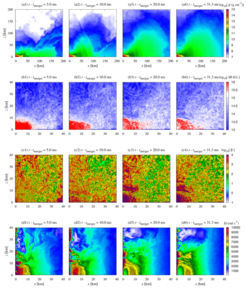High-resolution simulations of strongly magnetized binary neutron star merger remnants
Detailed simulation of binary neutron star merger and successive formation of massive remnant and torus shows how magneto-turbulence creates viscosity
With a high-resolution simulation (finest grid cell size 12.5 meters) researchers show that magneto-hydrodynamic instability amplifies the magnetic field in a binary neutron star merger, and that magnetorotational instability in the remnant massive neutron star (RMNS) and matter torus create effective viscosity. To extend their simulation to the high-density central region of the RMNS will require futher ultra high-resolution simulations.
Paper abstract

We perform a general-relativistic magnetohydrodynamics simulation for ≈ 30 ms from merger of a binary neutron star throughout the formation of a remnant massive neutron star (RMNS) with a high spatial resolution of the finest grid resolution 12.5 m. First, we show that the Kelvin-Helmholtz instability at merger could amplify the magnetic-field energy at least up to ∼ 1% of the thermal energy. Then, we show that the magnetorotational instability in the RMNS envelope and torus with ρ < 1013 g cm-3 sustains magneto-turbulent state and the effective viscous parameter in these regions is likely to converge to ≈ 0.01–0.02 with respect to the grid resolution. We also point out that the current grid resolution is not still fine enough to sustain magneto-turbulent state in the RMNS with ρ ≥ 1013 g cm-3.












